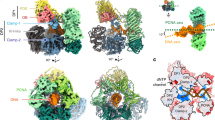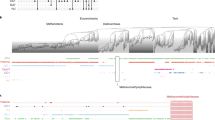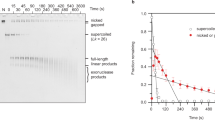Abstract
THE DNA of bacterial cells, gently isolated in the presence of high concentrations of monovalent salts, remains folded in a particle resembling the bacterial nucleoid1,2. The double-helical DNA is condensed by folding1 and by supercoiling3 and the compact structure is dependent both on counterions in the solvent environment and RNA molecules bound to the DNA1–4. In the absence of these stabilising interactions the DNA unfolds and acquires the usual properties of extended double-helical DNA1,3. The concentrations of monovalent salts required during the isolation of folded DNA are significantly greater than those found in the cell. It is, however, believed that in vivo polyamines may be an important counterion neutralising DNA5. We have now found that moderate concentrations of the polyamine spermidine greatly stabilise the condensed DNA conformations in isolated nucleoids. In addition to broadening current understanding of the role of counterions in stabilising condensed DNA states, this finding will be of significance to studies in which the stability of the nucleoid in vitro is important.
This is a preview of subscription content, access via your institution
Access options
Subscribe to this journal
Receive 51 print issues and online access
$199.00 per year
only $3.90 per issue
Buy this article
- Purchase on Springer Link
- Instant access to full article PDF
Prices may be subject to local taxes which are calculated during checkout
Similar content being viewed by others
References
Stonington, O. G., and Pettijohn, D. E., Proc. natn. Acad. Sci. U.S.A., 68, 6–9 (1971).
Pettijohn, D. E., Hecht, R., Stonington, O., and Stamato, T., in DNA synthesis in vitro (edit. by Wells, R., and Inman, R.), 145–162 (University Park Press, Baltimore, 1973).
Worcel, A., and Burgi, E., J. molec. Biol., 71, 127–147 (1972).
Pettijohn, D. E., and Hecht, R., Cold Spring Harb. Symp. quant. Biol., 39, 31–41 (1973).
Cohen, S., Introduction to the polyamines (Prentice Hall, Engle-wood Cliffs, New Jersey, 1971).
Worcel, A., and Burgi, E., J. molec. Biol., 82, 91–105 (1974).
Cummings, D., Virology, 23, 408–418 (1964).
Tabor, H., Biochem. biophys. Res. Commun., 3, 382–385 (1960).
Steven, L., Biochem. J., 103, 811–815 (1967).
Hiebert, E., and Baucroft, J., Virology, 39, 296–311 (1960).
Datta, R., Sen, S., and Ghosh, J., Biochem. J., 114, 847–854 (1969).
Scott, B., and Cohen, S., Biochem. J., 55, 23–33 (1953).
Glasser, R., and Gabbay, E., Biopolymers, 6, 243–254 (1968).
Author information
Authors and Affiliations
Rights and permissions
About this article
Cite this article
FLINK, I., PETTIJOHN, D. Polyamines stabilise DNA folds. Nature 253, 62–63 (1975). https://doi.org/10.1038/253062a0
Received:
Revised:
Issue Date:
DOI: https://doi.org/10.1038/253062a0
This article is cited by
-
Spermidine and abscisic acid-mediated phosphorylation of a cytoplasmic protein from rice root in response to salinity stress
Acta Physiologiae Plantarum (2012)
-
Regulatory mechanisms of polyamine biosynthesis in plants
Genes & Genomics (2009)
-
Effects of polyamines on proliferation and IgM productivity of human–human hybridoma, HB4C5 cells
Cytotechnology (2008)
-
Immunocytochemical demonstration of polyamines in nucleoli and nuclei
Histochemistry and Cell Biology (2008)
-
A new approach to DNA bending by polyamines and its implication in DNA condensation
European Biophysics Journal (2006)
Comments
By submitting a comment you agree to abide by our Terms and Community Guidelines. If you find something abusive or that does not comply with our terms or guidelines please flag it as inappropriate.



